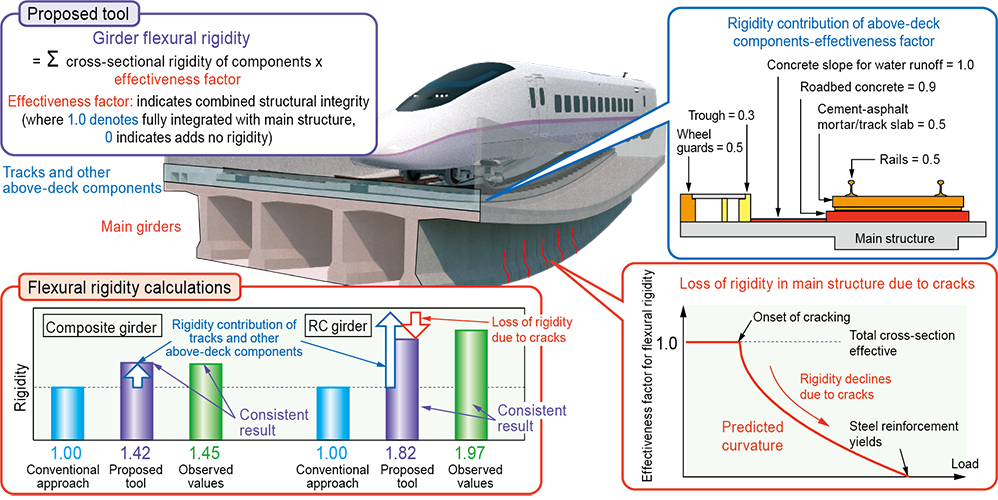17. Method for evaluating girder vibration characteristics with consideration for track rigidity
Some Shinkansen bridges exhibit significant resonance vibration as trains pass over. In order to accurately predict the vibration characteristics of a bridge, we need to calculate the flexural rigidity of its girders. Conventional girder design does not consider the rigidity contribution of the tracks and other above-deck components such as roadbed concrete, track slabs and wheel guards, simply because we do not have a proper understanding of their respective rigidity contributions. As a result, girder designs are often uneconomical. We have developed a method for calculating girder flexural rigidity that incorporates consideration for the rigidity of tracks and other above-deck components (Figure 1 upper left). The method even takes into account loss of rigidity associated with cracks in concrete members, in order to provide a more realistic picture of overall structural integrity.
Tracks and other components used on bridges vary widely in terms of type, shape and design. In addition, cracking behavior is different depending on structural types such as concrete and composite girders. Our method incorporates these differences into the girder flexural rigidity calculation by multiplying the cross-sectional rigidity of each component by the effectiveness factor, a simply used indicator of combined structural integrity (the degree of structural integration with the main structure). Through a combination of finite-element method analysis and observation of different girder structures, we have quantified individual effectiveness factors for the rigidity of tracks and other above-deck components (Figure 1 upper right). In addition, we have used fatigue testing to develop a dedicated formula for the effectiveness factor of concrete girders with bending cracks, which can be used to estimate the progress of cracking under repetition and the associated decline in flexural rigidity (Figure 1 lower right). The accuracy of the method has been validated via actual bridge measurements (Figure 1 lower left). The rigidity of reinforced concrete (RC), pre-stressed concrete (PC) and composite girders has conventionally been underestimated. Our method strips up to 50% off the vibration amplitude factor during train passages for such girders. In the example of the RC girder in Figure 1, rigidity is shown to increase by 80% while the vibration amplitude factor drops by 50%, leading to an overall 10% saving in the quantity of steel used in the bridge design.
Other Contents
- 9. Integrated analytics platform for railways
- 10. On-board obstacle detection system suitable for low-light conditions
- 11. Tool for estimating bridge deflection from on-board track irregularity measurements
- 12. Wear measuring apparatus for overhead conductor rail using light sectioning
- 13. Imaging analysis method for detecting various anomalies in overhead contact lines
- 14. Automated crew scheduling system
- 15. Fast-track embankment structure for confined settings
- 16. Numerical analysis method for predicting interaction impacts on closely adjacent tunnels
- 17. Method for evaluating girder vibration characteristics with consideration for track rigidity
- 18. Concrete repair methodology based on crack width and location
- 19. Using expansive concrete in track slabs to minimize reinforcement
- 20. Using temperature sensors to help predict service life of electronic signallingequipment
- 21. Effective and efficient steam weeding technique
- 9. Integrated analytics platform for railways
- 10. On-board obstacle detection system suitable for low-light conditions
- 11. Tool for estimating bridge deflection from on-board track irregularity measurements
- 12. Wear measuring apparatus for overhead conductor rail using light sectioning
- 13. Imaging analysis method for detecting various anomalies in overhead contact lines
- 14. Automated crew scheduling system
- 15. Fast-track embankment structure for confined settings
- 16. Numerical analysis method for predicting interaction impacts on closely adjacent tunnels
- 17. Method for evaluating girder vibration characteristics with consideration for track rigidity
- 18. Concrete repair methodology based on crack width and location
- 19. Using expansive concrete in track slabs to minimize reinforcement
- 20. Using temperature sensors to help predict service life of electronic signallingequipment
- 21. Effective and efficient steam weeding technique

